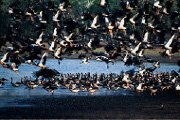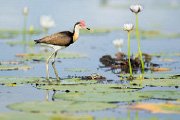Flying fox
Flying foxes are large, vegetarian bats that live in forested areas.
Kakadu is home to two flying fox species: the black flying fox and the little red flying fox.
Unlike many bats, flying foxes don’t use echolocation to navigate. Instead, they rely on their excellent eyesight and sense of smell to locate food, travelling many kilometres every night.
Where to see it
During the day, flying foxes roost in large, noisy colonies located in mangroves, paperbark forests and monsoon rainforests.
If you look upwards at dusk, you might see them flapping through the sky as they head out to feed.
Behaviour
Flying foxes are very social animals. They call to one another constantly, so large colonies can get very loud.
Flying foxes fly up to 30 km a night in search of fruits and nectar. As they eat and travel, they spread seeds and pollinate many native plant species, including paperbark trees. That means these raucous flying mammals play a role in making Kakadu’s landscape the beautiful place it is.
Scientific name
Pteropus scapulatus (little red flying fox) and Pteropus alecto (black flying fox)
Take the first step
A journey of 1000 miles begins with a single click.
Enter your email to get free trip planning advice from Kakadu rangers.





